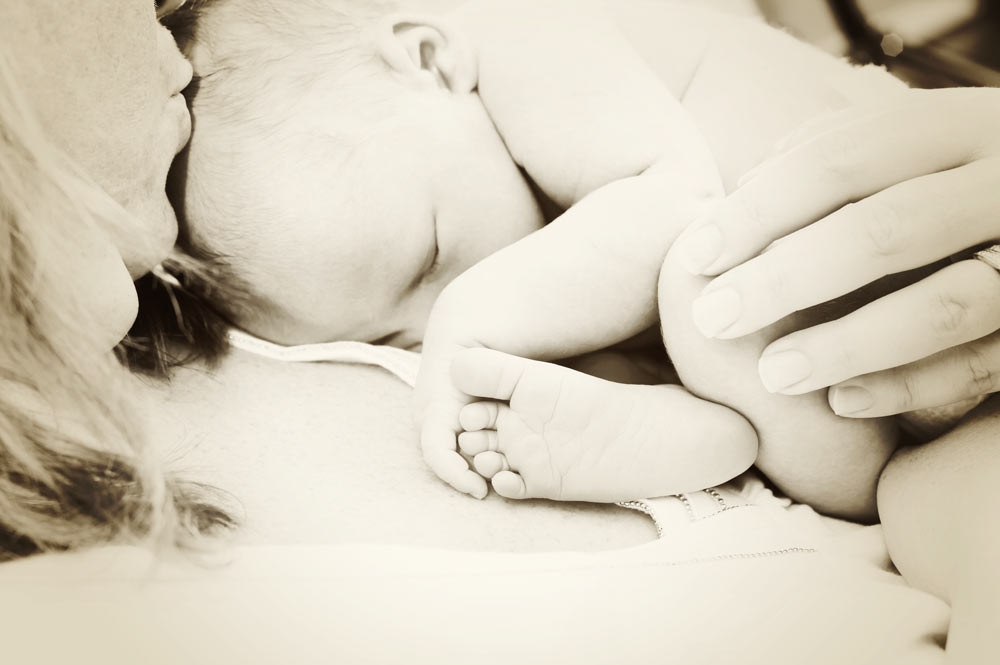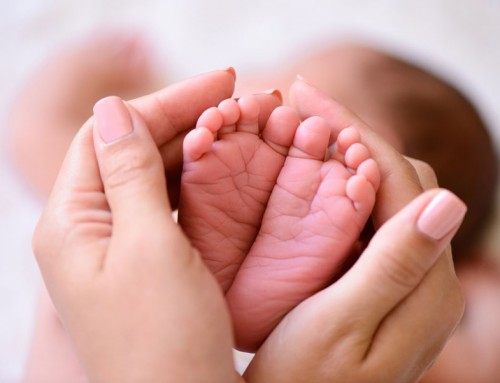Q: I have heard that some midwives and doctors place the baby skin to skin with the mother right after delivery. Do you do this, and what are the benefits to the mom and baby?
It is our usual practice to place the newborn skin to skin with mom right after birth. The baby will normally be dried off and placed under the mother’s gown against her bare chest or abdomen (depending on how long the umbilical cord is, and whether it has been cut yet). Once cord pulsation ceases and the cord is cut baby can be moved higher up on mom’s chest so eye contact can be made. Many studies have been done that show the long and short term benefits of skin to skin care at birth. Babies who have skin to skin contact are much more likely to have a normal, stable temperature, while babies who are wrapped in blankets or placed under heating lamps have trouble with temperature regulation. Skin to skin contact has been shown to help regulate baby’s heartbeat, blood pressure and respirations as well. Blood sugars are consistently higher when baby is placed skin to skin, which decreases the chance of having supplementary feedings recommended.
Skin to skin care at birth leads to a much higher rate of breastfeeding success, including latching on, latching well, and exclusive breastfeeding for a longer period of time. Skin to skin also decreases the “stress hormones” that can occur in both mom and baby, leading to less crying in the baby, and a calm, happy, relaxed mother, facilitating mother/baby bonding. Another benefit of this practice for the newborn is colonization with the mother’s bacteria. When baby is right on mom’s chest, s/he will be exposed to the mother’s bacteria, rather than the hospital bacteria or the nurse’s bacteria. This is important for the development of the baby’s immune system as well as for prevention of allergies. Finally, skin to skin care at birth promotes optimal brain development…..
After the baby is born, it is the baby nurse’s responsibility to make sure that baby’s temperature, heart rate and respirations are normal and to do routine tasks such as weighing and measuring the baby and giving baby medications. These things can either be done while baby is skin to skin, or delayed until the baby is one hour post birth. The baby’s weight will not change that quickly!
There may be cases when skin to skin care may not be possible, or may be delayed. If a cesarean section occurs, it may be possible to do skin to skin care, but if not, the baby may be placed skin to skin with the father or other relative. The same holds true in the case that the mother has an emergency after vaginal birth and is unable to do immediate skin to skin care. In the event of a baby having to be cared for in the Neonatal Intensive Care Unit (NICU), immediate skin to skin care may not be possible but parents will be able to visit the baby and usually will be able to do some skin to skin care in the NICU. It can be devastating to have your baby separated from you, but those moments of skin to skin are healing and will help your baby improve more quickly (and go home with you faster).
Because the benefits of skin to skin care are so well documented, many organizations advocate for this as a standard of care at delivery. These organizations include the World Health Organization, the American College of Nurse Midwives, the American College of Obstetricians and Gynecologists, and the American Academy of Pediatricians, among others.
Baby should ideally be skin to skin for the first hour, which is often called the “golden hour” or the “sacred hour” and then periodically as much as is practical during the first 24 hours. Dad can share in this as well. Of course, having your baby skin to skin right after birth will be a great reward for all the hard work you went through during labor and birth! Continue skin to skin when you go home as well; it will continue to facilitate bonding and breastfeeding.


 Online Scheduling Request
Online Scheduling Request 





